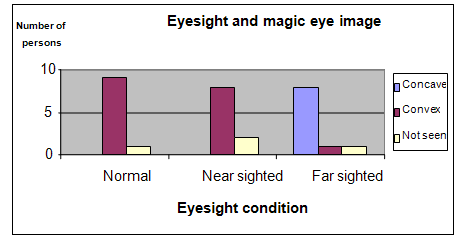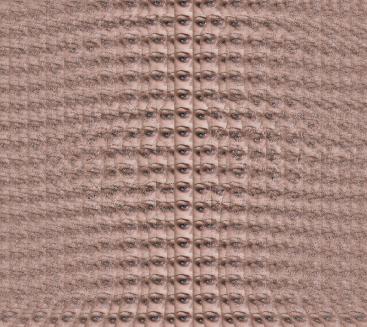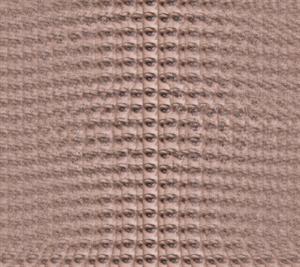| Complexity level: | 8 |
| Project cost ($): | 40 |
| Time required: | 1 hour to prepare, 1 hour for the science fair project experiment |
| Material availability: | Easily found at a book store or gift shop |
| Safety concerns: | None |
Hypothesis
Persons with different eyesight conditions will perceive the image in the magic eye pattern differently.
Overview
Magic eye stereogram
Magic eye images or auto-stereograms are two-dimensional patterns that allow the viewers to see a three-dimensional image, if they diverge their eyes and look at 2 different points at the same time. To view the three-dimensional image the brain needs to overcome the usual eye coordination method of focus and verging.
Magic eye images are made up of patterns that are repeated horizontally. The repetitive patterns will have a slight variation in their arrangement along the horizontally repeated line. When our two eyes are made to focus on different points on the images, an illusion of depth is perceived by our brain.
To view the three dimensional image in the magic eye stereogram, the viewer will need to converge the two eyes and focus on a point that is located behind the picture or screen. This will place both of our eyes on different points or patterns in the picture and trick our brain into seeing a three dimensional image or depth. By increasing or reducing the distance between the repeating patterns, an illusion to make the area appear closer or further can be created.
Scientific Terms
Materials
The materials required for the science fair project experiment:
- A magic eye stereogram with a 3-D image of a soda can
- A magic eye stereogram book
- Standard color dot test
- 10 participants with normal vision
- 10 participants with near-sighted vision
- 10 participants with far-sighted vision
Procedure
1. For this science fair project, the independent variable is the eyesight condition of the participants – normal, near-sighted or far-sighted. The dependent variable is the appearance of the 3-D image viewed by the participants. This is determined from the feedback given by the participants on what they saw in the magic eye stereogram. The constants (control variables) are the magic eye image and the lighting conditions in the room.
2. Participants with normal vision are first tested using the standard color dot test book to check if any of them are color blind. The color dot test is also repeated on the near-sighted and far-sighted participants. Any participant who is found to be color blind is replaced with another new participant.
3. For the next 1 hour the 20 participants are provided with explanations and training on how to gaze at a magic eye image. Give them a demonstration and test their ability to look at a 3-D image in a magic eye picture.
4. After the explanations, training and demonstrations are completed, the participants are requested, one at a time, to look at a magic eye stereogram with a 3-D image of a soda can inside. The participants are asked if the shape of the can that they are looking at appears to be a regular shaped can, or if it is concave or convex in shape. Each participant is given only 3 minutes to look at the image and if they are not able to identify the can, then they will be recorded as having been unable to see the image.

5. The results of the reply from the participants are totaled for each group and recorded in the table given below.


Results
The results showed that the participants with normal and near-sighted vision saw the soda can in the magic eye image as appearing to be convex in shape. The participants with far-sighted vision saw the same soda can in the magic eye image appear to be concave in shape.
|
Normal |
Near sighted |
Far sighted |
|
|
Concave |
0 |
0 |
8 |
|
Convex |
9 |
8 |
1 |
|
Not seen |
1 |
2 |
1 |
The chart below represents the results of our science project experiment.

Conclusion
Our hypothesis has been proven to be true. Persons with different eyesight conditions will perceive the image in the magic eye pattern differently.
Magic eye images are normally used to demonstrate optical illusions for fun or for learning science by both adults and children. Interestingly, magic eye images are also used by vision therapists used for the treatment of binocular vision or similar disorders.
Also consider
To improve the reliability and accuracy of our results, a larger sample of participants should be used.
This science fair project may be repeated, this time, by comparing different age and gender of the participants.
Modify the science project experiment, using the standard color dot test.
References
Autostereogram - http://en.wikipedia.org/wiki/Autostereogram
Magic eye - http://en.wikipedia.org/wiki/Magic_Eye

